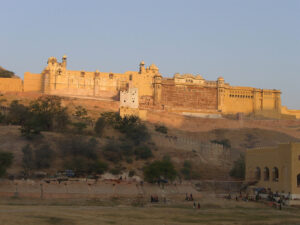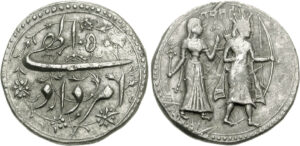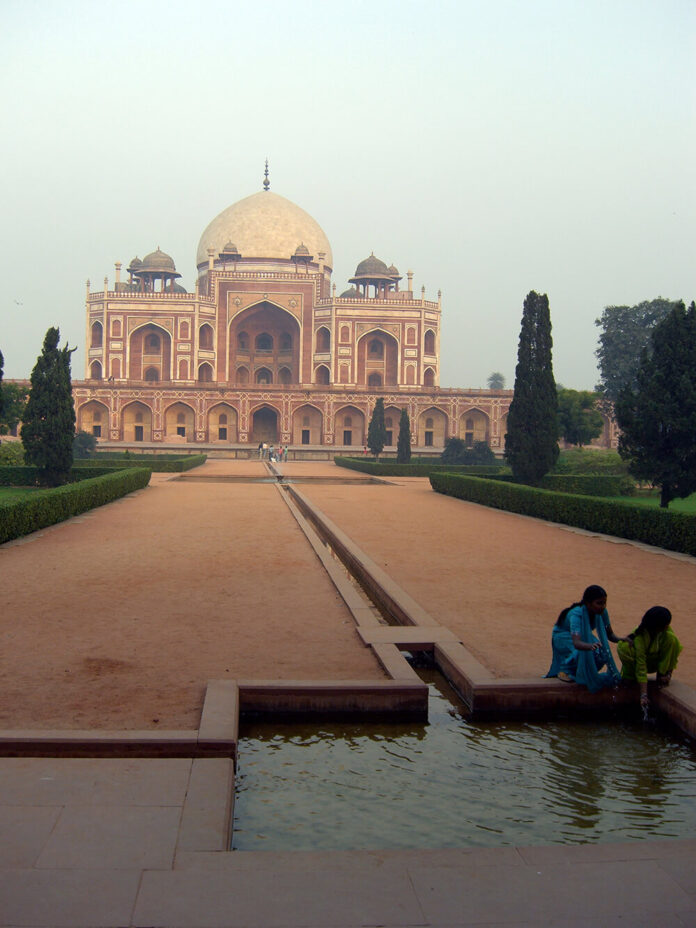It almost sounds like a fairy tale: a prince conquers a kingdom, his son loses it, and his grandson establishes an empire whose splendour and grandeur were to inspire the generations to come. The Muslim Mogul Akbar founded an empire in which Hindus and Muslims live together in peace. Today, in this article, we use coins to tell how Akbar ended up on the throne of Delhi and what role his grandfather and his father played in that.

Akbar’s Grandfather: Babur
The young Zāhir ad-Dīn Muhammad Bābur was 14 years old when he inherited the rule of Samarkand in 1497. He experienced a disappointment: the Uzbeks forced him to leave his empire. His army was not able to oppose the enemies. For about 15 years, Babur (= the beaver) fought to reclaim the territories he had lost – in a more or less successful manner. In any case, the young commander learned a lot during the process and when he decided to finally give up the fight for Samarkand and to turn his attention to new objectives, he was able to draw on the lessons of his defeat.
Babur had developed a very special strategy during his battles: he combined fast cavalry troops with an agile field artillery. That was quite new. Only the Ottomans were ahead of his strategy: at the time, they proved that their cannons were invincible in the conquest of the Balkans. Babur’s advance became a triumphal procession, too. First he conquered Afghanistan and set up a centre in Kabul from where he could move on towards India. There, people neither knew cannons nor handguns. It is said that those who defended the first castle Babur attacked laughed about the weird sticks before they had to take cover as bullets were fired all over them.
The new way of fighting cost a lot of money, but it was effective. With his unconventional ideas, Babur defeated armies that were more than ten times larger than his. He conquered castles that had been considered unconquerable before. The artillery could easily compensate for the high costs by means of the abundant booty. Within a few years, Babur conquered Delhi and Agra. These two cities were to become the centre of a new empire, the empire of the Mughal Emperors.
Akbar’s Father: Humayun
Whereas Babur had had to fight hard for everything, his son Nasir ud-Din Muhammad Humayun was left with a pacified India when he took over the rule on 26 December 1530. But it did not take long until the usual difficulties arose: There was no birth right in the Mughal Empire. Every prince was legally qualified to take over the reign once he had proven himself in the struggle for power. Of course, the ministers interfered in the matter because they wanted to weaken the position of the ruler as much as possible to make him grant them great power.

The conflicts with his brothers and cousins resulted in Humayun losing the throne because he had to leave the centre of the Mughal Empire to fight rebellions in the periphery. This was the perfect opportunity for a former supporter of the Sultan of Delhi, Farid-ud-Din Abul Muzaffar known as Sher Khan (= the Tiger King) who had been banished by Babur and founded the short-lived Sur dynasty.
Sher Khan had used Humayun’s quarrels with his brothers to conquer the rich region of Bengal. Humayun failed to move his army quickly enough against Sher Khan, which is why he was able to back off and barricade himself in the neighbouring province. Humayun entered Bengal’s capital and stayed there for nine months without taking decisive action. This rare piece must have been minted during this time. Only when the monsoon set in and it was too late for any military action, Humayun withdrew his army. He encountered new rebellions that had come up as a result of his inactivity. Humayun couldn’t do anything but flee. With few supporters and even less money, Babur’s successor begged his way from court to court.

In 1542 his son Akbar was born. Humayun did not bother himself with the infant. He left it with his brother in Afghanistan before going into exile in Persia. Only when Sher Khan had died in 1545 and his son in 1554, Humayun returned to India with Persian help: now, it was he who took advantage of the battle over Sher Khan’s succession.
On 23 July 1555, Humayun was back on his father’s throne in Delhi. He died less than one year later. A stupid accident put an end to his life: his hands full of his beloved scriptures, he descended the steep stairs of the library in his palace. Then, the devout Muslim heard the call of the muezzin. Humayun turned around, got tangled in his long robe and stumbled. The emperor fell down the stairs and broke his neck – at least that’s how the official version goes. If you know a little bit about the alcohol and drug consumption at the Mughal court, you might suspect that Humayun was not entirely sober when he went down those stairs.

Akbar Takes Over the Rule
Anyway, at the time of Humayun’s death, Akbar – whose full name was Jalal-ud-Din Muhammad Akbar – was only 13 years old. He was lucky: only two months before his death, Humayun had appointed his most able advisor and general, Bairam Khan, Akbar’s guardian. Bairam saved the adolescent’s empire when a pretender to the throne conquered the capital of Delhi with a huge army and 300 elephants. Many courtiers thought that Akbar’s fate had already been decided, but Bairam gathered the troops, encouraged them and defeated the enemy in a great battle. 13-year-old Akbar witnessed it in person. He had grown up among warriors in Afghanistan and knew how to use a sword: it was he who – on the orders of his guardian – chopped off the head of the dying opponent.
The young man could have kept things that way and lived a comfortable life. After all, there was an accomplished minister to do the work for him, but that wasn’t the mindset of the new ruler. In 1560/1 he put an end to the influence of two mighty groups at court by first having Bairam removed and then Adham Khan, his milk-brother, the son of his wet nurse. Thus, Akbar had already proved that he was prepared to pursue his interests in a ruthless way before he even turned 18. He had also established himself as a supreme autocrat whose word was more important than any intrigue at court.

The Lion-Limbed
We know how Akbar must have looked like from numerous very realistic paintings and from a description by his son Jahangir: “Of medium height but rather tall; wheat-coloured; his eyes and eyebrows were black and his skin rather dark than pale; he was lion-limbed with a large chest, long arms and hands. On the left side of his nose, he had a fleshy wart of the size of half a pea, very pleasant to look at. Experts of physiognomy consider this feature to be a sign of prosperity and great fortune. His sublime voice was very loud and especially rich when he spoke and explained.”

Hindus and Muslims
We don’t want to chronicle every war that Akbar had to wage in order to make the small dominion of Delhi he had taken over from his father become the mighty Mughal Empire that covered most of northern India at the time of his death.
We only need to mention that his conquests made Akbar become the sovereign of countless Hindus. For the survival of the empire, it was necessary that they accepted Akbar’s (Muslim) rule. Creating harmony between both religions became Akbar’s most demanding task. Overcoming this problem made and still makes him one of the most controversial figures in Indian history: while orthodox Muslims still condemn him because of his apostasy, liberal Indians believe him to be a role model who proves that a reconciliation of religions is possible.

At first, Akbar had to deal with practical problems: there were the Hindu Rajputs, local rulers who resided in castles that were usually difficult to access and from where they exercised their limited power. It was a lot of work to subjugate them all. Although it was effective to use cannons in the mountains, it was very costly and just possible for a short amount of time. Akbar soon realised that he would not be able to exercise direct rule in Rajasthan: the distances were too far and his enemies had too many opportunities to barricade themselves.
Therefore, he pursued the approach of reconciliation. Akbar did not force any of the defeated princes to convert to Islam. He married the daughter of a powerful Rajput, the Lord of Amber. It was the first marriage between a Muslim and a Hindu dynasty. From then on, there were to be much more. The Rajputs who were willing to cooperate maintained their power. Akbar imposed nominal suzerainty: Rajputs had to pay taxes and support him in the case of war.


Nevertheless, not everyone was willing to subjugate to the rule of Delhi. Time and again there were uprisings in Rajasthan. However, arranging an imperial hunt in the region was often everything Akbar needed to do to restore peace. After all, an entire army was needed for the traditional form of Mughal hunting. For weeks, a huge area was sealed and the animals that lived in there were herded closer and closer together. The larger the region, the more military presence was needed – and this show of force was often enough to nip an uprising in the bud without using violence.
Normal citizens also benefited from Akbar’s willingness to cooperate. Despite the strong disapproval of his orthodox mullahs, he insisted on equal rights of subjugated Hindus and ruling Muslims. In 1564, he abolished the poll tax that Muslim rulers were traditionally entitled to impose on their “unbelieving” subjects. This made the Hindus support Akbar.

Fatehpur Sikri
Akbar was tormented by one great worry. Many years he had to wait for a successor. The sons born to him died very young. But a religious leader, Sheikh Selim Tschischti in Sikri, to whom Akbar went on pilgrimage, prophesied that he would have three sons. A short time later, one of Akbar’s wives (at the end of his life he had 300) became pregnant. She gave birth to a son on 30 August 1569, who was first named Salim and succeeded his father on the throne as Jahangir. Only one year later the second, two years later the third heir was born.
Akbar is said to have been so impressed by the accurate prophecy that he decided to build a new capital in Sikri in honour of the sheikh, which is today’s Fatehpur Sikri, one of the most interesting ruined cities of India. Its name “city of victory” could also refer to another event: in 1568, Akbar crushed Rajput resistance in Chittor and Ranthambore. Akbar could have intended Fatehpur Sikri to be a testimony to this victory. Either way, the city bears witness to the spirit of innovation and tolerance that dominated Akbar and his politics.

The Diwan-e-Khas, the Hall of Private Audiences, is very popular: it is characterised by a single, richly decorated column, on top of which is a platform for the ruler’s throne. The platform is connected by walkways to a surrounding gallery, on which Akbar’s advisers stood waiting for a sign from the emperor to approach him and tell him about their opinion. The officials stood underneath them, they were considered worthy of listening but not of speaking.

When one of Akbar’s famous religious discussions took place there, Hindus, Muslims, Parsis and – at the latest since 1580 – Jesuits gathered on the four sides of the room, arranged according to their faith to keep quarrels to a minimum.
This is probably also the room where Akbar received the first visits of Europeans: in 1583, Queen Elizabeth I of England sent a letter to the Mughal emperor asking him to grant her people the monopoly on trade with India. Akbar did not even consider it necessary to send a reply. To him, Englishmen and Portuguese were mere supplicants to whom the desired goods – jewels and carpets, fine fabrics and spices – were only given in exchange for cash payments in silver. Under Akbar, the lucrative trade via the new sea routes began to flourish but it would take centuries until the East India Company was to dominate India.
After only 14 years, Akbar abandoned his capital – we don’t know whether it was for strategic reasons or because there was not enough water for his beloved fountains and gardens.
The Daily Life at Court
Although the world of the Mughal people seems mysterious to us, there are only few historical periods that have left us with such an abundance of written sources. Besides the autobiographies of Babur and Jahangir, we also have excellent historical accounts from the time of Akbar’s rule. The court writer Abul Fasl, for instance, was commissioned by the emperor to record everything that was important (and occasionally also a lot that was rather unimportant). His eulogies are complemented by the book of Badauni, a downright bigoted Muslim who hated Akbar for his tolerance. Together, these writings illustrate quite well what happened in the Mughal Empire. They also provide enough information in order to reconstruct the daily life of a Mughal ruler.
First of all, it was not an easy job to administer the Mughal Empire. Thus, Akbar’s day started before sunrise with morning prayers. After that, he showed himself to his subjects on a small balcony to let his beneficial presence shine over them, a practice that people like Badauni considered an act of hubris.
After his grand show, the ruler had a short hour to himself, afterwards he had to go the great hall of audiences where he sat down on his throne, which was covered with cushions. Behind him were eunuchs who fanned him. His guards stood to his right and left, among them were also executioners to execute any sentence of the ruler immediately.
In front of the platform, there were the great men of the empire. Anyone who held an office had to attend the audience twice a day. Those who did not appear were fined. They were the audience for promotions, honours and supplicants. The orderly hierarchy of the entourage impressed the first Europeans who visited the Mughal court because they were not used to such strict standards of etiquette from their home. Even the slightest violation was punished.
After the public audience, the emperor held private audiences at about 10 a.m., and at 11.30 a.m. he discussed confidential matters with the small council. He then went into the harem where he had a snack and answered the petitions of his wives, who also formed part of the government.
At 3 p.m. was his afternoon prayer, which was followed by the second great audience. In the evening, the ruler went to the harem, listened to music, ate and relaxed before going to bed. While listening to a reader, he fell asleep.
You see, he had a tight schedule that looked somewhat similar every day, at least when he stayed at one of his palaces. However, Akbar’s ancestors had been nomads and he was so often on the road that he also had two tent palaces for travelling in addition to his stone palaces.
In part 2 of this article you’ll learn about the challenges Akbar had to face and the principles he relied on when minting coins.
And here you’ll find out why the stars played an important role at the court – and in the coinage – of Akbar’s son, the Mughal emperor Jahangir.
You can find a tour of Fatehpur Sikri, the former capital of Akbar’s empire, on YouTube.




